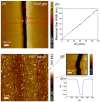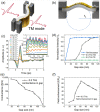Strain versus Tunable Terahertz Nanogap Width: A Simple Formula and a Trench below
- PMID: 37764555
- PMCID: PMC10537752
- DOI: 10.3390/nano13182526
Strain versus Tunable Terahertz Nanogap Width: A Simple Formula and a Trench below
Abstract
A flexible zerogap metallic structure is periodically formed, healing metal cracks on a flexible substrate. Zerogap is continuously tunable from nearly zero to one hundred nanometers by applying compressive strains on the flexible substrate. However, there have been few studies on how the gap width is related to the strain and periodicity, nor the mechanism of tunability itself. Here, based on atomic force microscopy (AFM) measurements, we found that 200 nm-deep nano-trenches are periodically generated on the polymer substrate below the zerogap owing to the strain singularities extant between the first and the second metallic deposition layers. Terahertz and visible transmission properties are consistent with this picture whereby the outer-bending polyethylene terephthalate (PET) substrate controls the gap size linearly with the inverse of the radius of the curvature.
Keywords: diffraction pattern; gaptronics; nano-trench; nanogap; pet substrate; terahertz; tunable zerogap.
Conflict of interest statement
The authors declare no conflict of interest.
Figures




References
-
- Lee G., Lee J., Park Q.-H., Seo M. Frontiers in terahertz imaging applications beyond absorption cross-section and diffraction limits. ACS Photonics. 2022;9:1500–1512. doi: 10.1021/acsphotonics.1c02006. - DOI
-
- Castro-Camus E., Koch M., Mittleman D.M. Recent advances in terahertz imaging: 1999 to 2021. Appl. Phys. B. 2022;128:12. doi: 10.1007/s00340-021-07732-4. - DOI
-
- Leitenstorfer A., Moskalenko A.S., Kampfrath T., Kono J., Castro-Camus E., Peng K., Qureshi N., Turchinovich D., Tanaka K., Markelz A.G. The 2023 terahertz science and technology roadmap. J. Phys. D Appl. Phys. 2023;56:223001. doi: 10.1088/1361-6463/acbe4c. - DOI
Grants and funding
LinkOut - more resources
Full Text Sources
Miscellaneous

